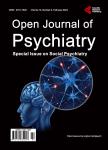A Prospective Study on the Incidence and Predictors of Postpartum Depression among Pregnant Women Attending an Antenatal Clinic in Kano, Northern Nigeria
A Prospective Study on the Incidence and Predictors of Postpartum Depression among Pregnant Women Attending an Antenatal Clinic in Kano, Northern Nigeria作者机构:Aminu Kano Teaching Hospital Kano Nigeria Department of Psychiatry Bayero University Kano Nigeria
出 版 物:《Open Journal of Psychiatry》 (精神病学期刊(英文))
年 卷 期:2023年第13卷第3期
页 面:207-220页
学科分类:1002[医学-临床医学] 100214[医学-肿瘤学] 10[医学]
主 题:Postpartum Depression Pregnant Women
摘 要:Depressive disorder is a major contributor to years lived with disability (YLD) globally. It is estimated that 13% of all women experience the disorder in the first year postpartum. Postpartum depression (PPD) has significant implications to the physical and mental wellbeing of both the mother and her baby. Only non-depressed pregnant women (score of ≤ 6 on Edinburgh Postnatal Depression Scale) were recruited into this study. Data collection was done at 2 different stages;at recruitment stage (during the third trimester of pregnancy) and at the follow up stage (4th - 6th week postpartum). During the recruitment stage, intimate partner violence (IPV) and level of social support perception, among the women, were assessed using Hurt Insult Threaten Scream (HITS) and Multidimensional Scale of Perceived Social Support (MSPSS) questionnaires respectively. While at the follow up stage, the Obstetric questionnaire and Mini International Neuropsychiatric Interview (MINI-7) were used respectively to obtain obstetric-related data and to diagnose for occurrence of depression. The incidence of PPD was found to be 16.34%. Several factors such as level of education, husband’s socioeconomic status, stressful life events, low perception of social support, obstetric instrumentation and not having a baby of preferred gender were significantly associated with PPD. Positive predictors of PPD included not practicing breast feeding (OR = 186.72, 95% CI = 8.32 - 4188.35), family history of mental illness (OR = 4.95, 95% CI = 1.04 - 23.81) and pregnancy lasting beyond 40 weeks (OR = 7.26, 95% CI = 1.51 - 34.88). High incidence of PPD with numerous associated but largely modifiable risk factors call for more proactive measures, such as PPD screening among pregnant women.



